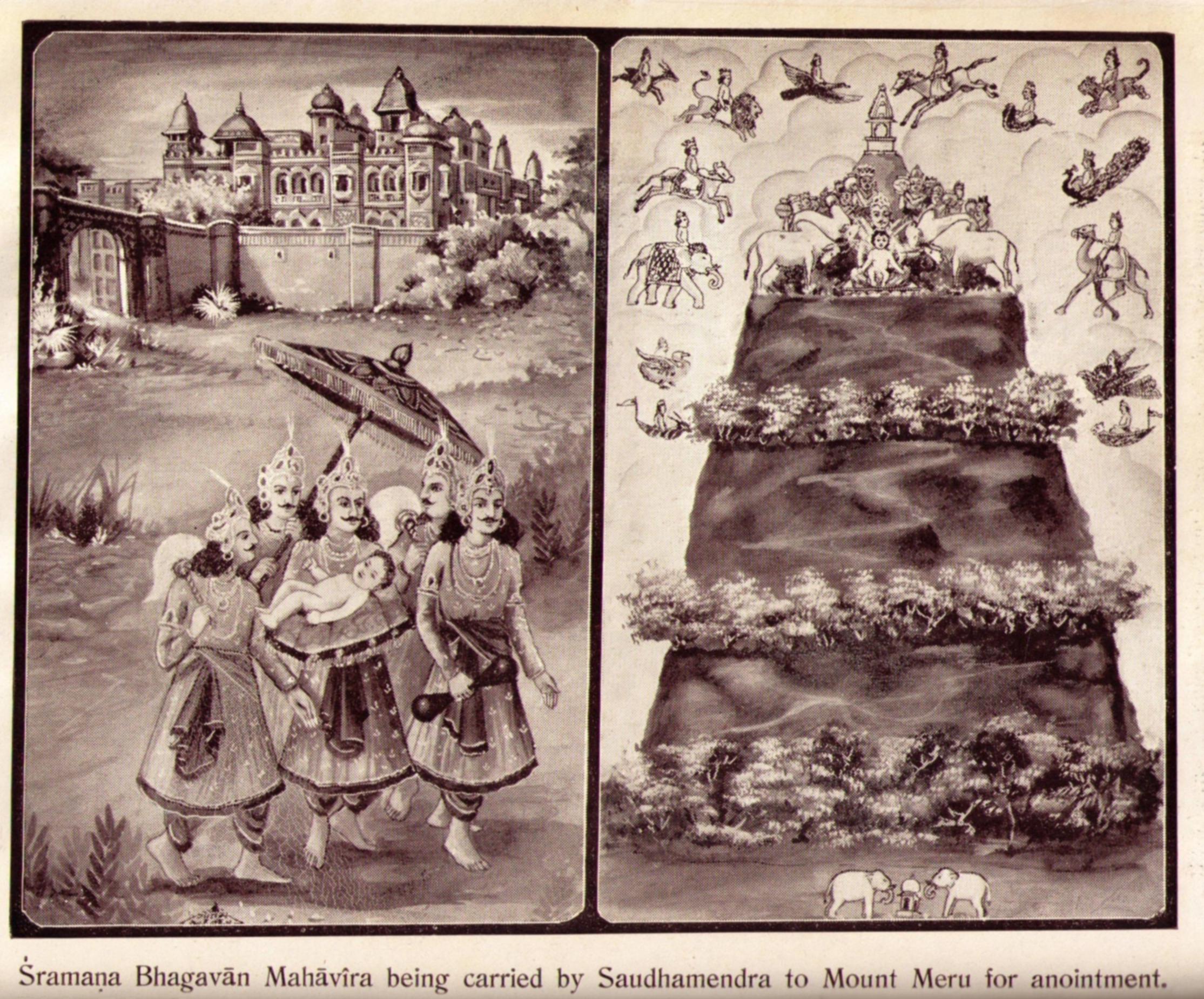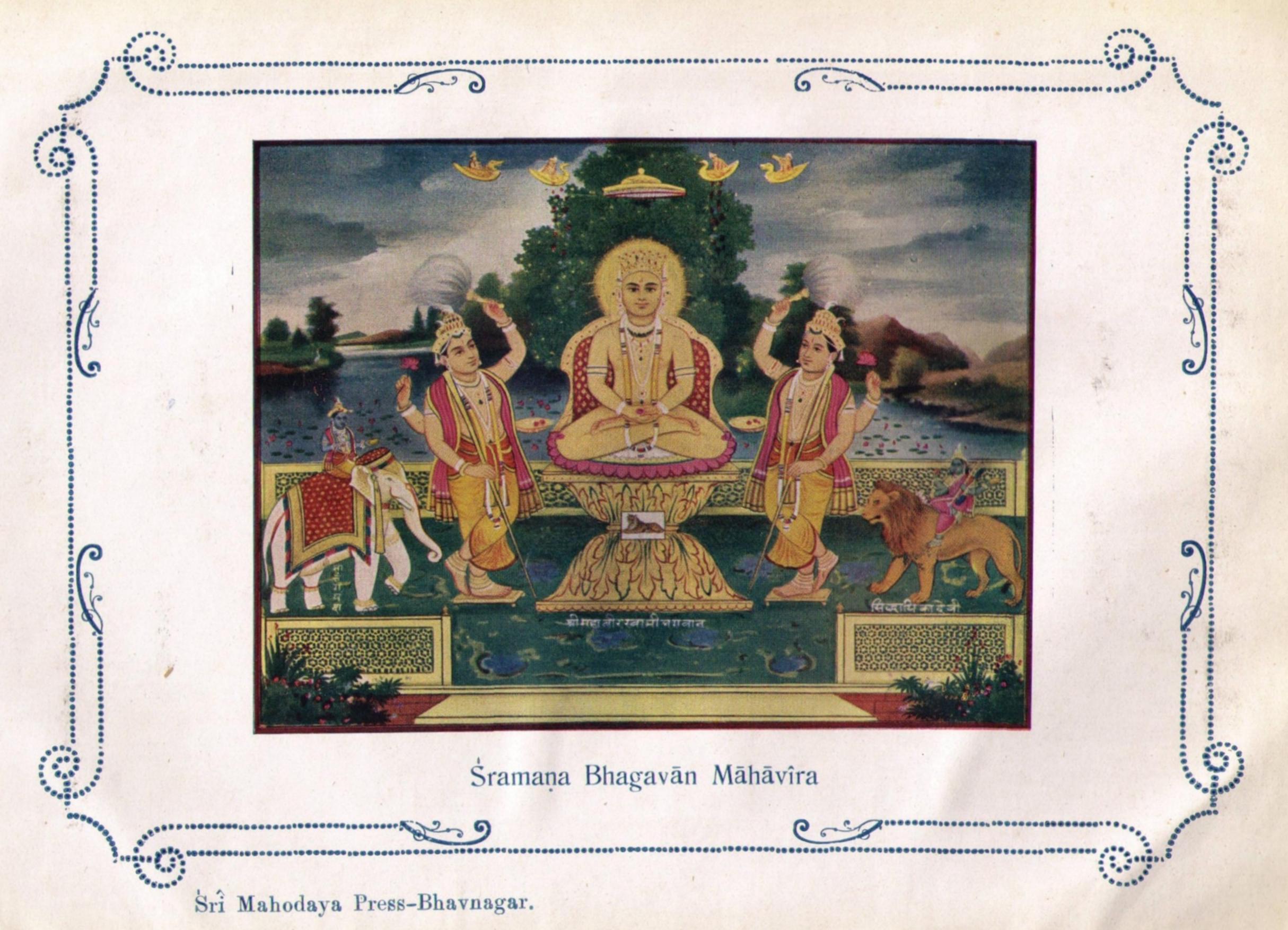This less known paper by Hermann Jacobi was presented on september 17th, 1908 on the occasion of the Third International Congress for the History of Religions, held at Oxford on September 15th - 18th, 1908. The paper was published in the conference transcript "Transactions of the Third International Congress for the History of Religions" (Edited by P. S. Allen and J. de Johnson. Oxford: Clarendon Press 1908, Vol. 2, pp. 59ff.) and was reissued later in the introductory section of the eight-volume edition Śramaṇa Bhagavān Mahāvῑra by Muni Ratna Prabha Vijaya (Volume I, Part I: Life, Ahmedabad: Śri Jaina Siddhānta Society, 1948, second edition, pp. 68-77).
The Metaphysics and Ethics of the Jainas
All who approach Jaina philosophy will be under the impression that it is a mass of philosophical tenets not upheld by one central idea and they will wonder what could have given currency to what appears to us an unsystematical system. I myself have held and given expression to this opinion but I have now learned to look at Jaina philosophy in a different light. It has, I think, a metaphysical basis of its own which secured it a distinct position apart from the rival systems both of the Brāhmaṇas and of the Buddhists. This is the subject on which I would engage your attention for a short space of time.
Jainism, at least in its final form which was given it by its last prophet-the twenty-fourth, Tīrthaṅkara Mahāvīra took its rise, as is well known in that part of Eastern India where in an earlier period, according to the Upaniṣads, Yājñavalkya had taught the doctrine of Brahman and Ātman, as the permanent and absolute Being and where the Mahāvīra's contemporary and rival - Gotama the Buddha - was preaching his Law, which insisted on the transitoriness of all things. Jainism, therefore, had to take a definite position with reference to each of these mutually exclusive doctrines, and these, it will be necessary to define more explicitly.
The one great truth which the authors of the Upaniṣads thought to have discovered and which they are never weary of exalting is that, underlying and upholding from within all things, physical as well as psychical, there is one absolute permanent Being, without change and with none other like it. The relation between this absolute Being and existent matter has not clearly been made out by the authors of the Upaniṣads, but all unprejudiced readers will agree that they looked on the phenomenal world as real. On this point, the different schools of Vedāntists arrived at different conclusions, which, however need not detain us here.
In opposition to this Brāhmanical doctrine of absolute and permanent Being, Buddha taught that all things are transitory; indeed his dying words were that all things that are produced must perish. The principal heresy, according to the Buddhists is the Ātmavāda i. e. the belief that permanent being is at the bottom of all things; they are, as we should say, but phenomena or as Buddha expressed it, dharmas; there is no dharmin, no permanent substance of which the dharmas could be said to be attributes.
Thus the Brāhmans and Buddhists entertained opposite opinions on the problem of Being because they approached it from two different points of view. The Brāhmaṇas exclusively followed the dictates of pure reason which force us to regard Being as permanent, absolute, and uniform; the Buddhists on the other hand, were just as one-sided in following the teaching of common experience according to which existence is but a succession of originating and perishing. Either view, the priori view of the Brāhmans and the a posteriori view of the Buddhists is beset with many difficulties, when we are called upon to employ it in explanation of the state of things as presented to us by our consciousness; difficulties which cannot be overcome without a strong faith in the paramount truth of the principle adopted.
The position taken by the Jainas towards the problem of Being is as follows: - Being, they contend, is joined to production, continuation and destruction (sad utpāda-dhrauvya-vināśa yuktam) and they call their theory, the Theory of lndefiniteness (anekānta-vāda) in contradiction to the theory of permanency (nitya-vāda) of the Vedāntists and to the theory of transitoriness (vināśa-vāda) of the Buddhists. Their opinion comes to this. Existing things are permanent only as regards their substance, but their accidents or qualities originate and perish. To explain: - Any material thing continues for ever to exist as matter; which matter, however, may assume any shape and quality. Thus clay as substance may be regarded as permanent but the form of a jar of clay or its colour may come into existence and perish.
The Jaina theory of Being appears thus to be merely the statement of the common-sense view, and it would be hard to believe that great importance was attached to it. Still, it is regarded as the metaphysical basis of their philosophy. Its significance comes out more clearly when we regard it in relation to the doctrines of Syādvāda and of the Nayas.

Syādvāda is frequently used as a synonym of Jaina Pravacana (e. g. at a later date in the title of a well-known exposition of the Jaina philosophy, entitled Syād-vāda Manjari) and it is much boasted as the saving truth leading out of the labyrinth of sophisms.[1] The idea underlying the Syād-vāda is briefly this: - Since the nature of Being is intrinsically indefinite and made up of the contrary attributes of originating, continuance and perishing, any proposition about an existing thing must, somehow, reflect the indefiniteness of Being i. e. any metaphysical proposition is right from one point of view, and the contrary proposition is also right from another. There are according to this doctrine, seven forms of metaphysical propositions, and all contain the word syāt e. g. syād asti sarvam, syād nāsti sarvam. Syāt means "may be" and is explained by katham cit which in this connection may be translated "some how". The word syāt here qualifies the word asti and indicates the indefinitness of Being. For example we say, a jar is somehow i. e. it exists if we mean thereby that it exists as a jar; but it does not exist somehow, if we mean thereby that exists as a cloth or the like.
The purpose of these seeming truism, is to guard against the assumption made by the Vedāntists that Being is one without a second, the same in all things. Thus we have the correlative predicates asti (is) and is not (nāsti). A third predicate is inexpressible (avaktavya); for existent and non-existent (sat and asat) belong to the same thing at the same time and such a co-existence of mutually contradictory attributes cannot be expressed by any word in the language. These three predicates variously combined make up the seven propositions or sapta-bhangas of the Syād-vāda. I shall not abuse your patience by discussing this doctrine at length; it is enough to have shown that it is an outcome of the theory of indefiniteness of Being (anekānta-vāda); and to have reminded you that the Jains believe the Syād-vāda to be the key in the solution of all metaphysical questions.
The doctrine of the Nayas which I mentioned before, is, as it were, the logical compliment to the Syād-vāda. The nayas are ways of expressing the nature of things; all these ways of judgement are, according to the Jainas, one-sided and they contain but a part of the truth. There are seven nayas, four referring to conception, and three to words. The reason for this variety is that Being is not simple, as the Vedāntists believe but is of a complicated nature, therefore, every statement and every denotation of a thing is necessarily incomplete and one-sided; and if we follow one way only of expression or of viewing things, we needs must go astray.
There is nothing in all this which sounds deeply speculative; on the contrary the Jaina theory of Being seems to be a vindication of common sense against the paradoxical speculations of the Upaniṣads. It is also, but not primarily directed against the Buddhistic tenet of the transitoriness of all that exists. We cannot, however, say that it expressly and consciously combats the Buddhistic view or that it was formulated in order to combat it. And this agrees well with the historical facts that Mahāvīra came long after the original Upaniṣads but was a contemporary of Buddha. He was obliged, therefore, to frame his system so as to exclude the principles of Brāhmanical speculation, but his the position was a different one with regard to the newly proclaimed system of Buddha.
I have not yet touched on the relation between Jain philosophy on the one hand, and Sāṅkhya-Yoga on the other. We may expect a greater community of ideas between these systems since both originated in the same class of religious men viz the ascetics known as Śramanas or to use the more modern term Yogins. As remarks the practice of asceticism, the methods and the aims of Yoga, it has long been proved that the Yoga of Brāhmaṇas, Jainas and Bauddhas, are closely related to each other and there can be no doubt they have all developed from the same source. But I am now concerned only with those philosophical ideas which have a connection with ascetic practice and form that justification there of.
Now, the Sāṅkhya view as to the problem of Being is clearly a kind of compromise between the theory of the Upaniṣads and what we may call the common-sense view. The Sāṅkhyas adopt the former with regard to the souls or puruṣas which are permanent and without change. They adopt the latter when assigning to matter or prakriti its character of unceasing change. The Sāṅkhyas contend that all things besides the souls or puruṣas are products of the one Prakriti or primieval matter and similarly the Jainas teach that practically all things besides the souls or jīvas are made up of Matter pudgala which is of only one kind and is able to develop into every thing. It will thus be seen that the Sāṅkhyas and Jainas are at one with regard to the nature of matter; in their opinion matter is something which may become anything.
This opinion, it may be remarked, seems to be the most primitive one; not only was it entertained by the ancients but also it underlies the universal belief of transformation occurring in the natural course of things or produced by sorcery and spells. This is a point I wish to make, that the Sāṅkhyas and Jainas started from the same conception of matter but worked it out on different lines. The Sāṅkhyas teach that the products of Prakriti are evolved in a fixed order, from the most subtle and spiritual one (Buddhi) down to the gross elements and this order is always reproduced in the successive creations and dissolutions of the world.
The Jainas on the other hand, do not admit such a fixed order of development of Matter (pudgala) but believe that the universe is eternal and of a permanent structure. According to them, Matter is atomic and all material changes are really going on in the atoms and their combinations. A curious feature of their atomic theory is that the atoms are either in a gross condition or in a subtle one and that innumerable subtle atoms take up the space of one gross atom. The bearing of this theory on their psychology I shall now proceed to point out. But I must premise that the Jainas do not recognize a psychical apparatus of such a complex nature as the Sāṅkhyas in their tenet concerning Buddhi, Ahamkāra, Manas and the Indriyas. The Jaina opinion is much cruder and comes briefly to this. According to the merit or demerit of a person, atoms of a peculiar subtle form which we call karma matter, invade his soul or jīva filling and defiling it, and obstructing its innate faculties. The Jainas are quite out-spoken on this point, and explicitly say that karman is made up of matter (pudgalikam karmam). This must be understood literally, not as a metaphor as will be seen from the following illustrations. The soul or jīva is extremely light and by it self it has a tendency to move upwards, but it is kept down by the karma matter with which it is filled. But when it is entirely purged of karma matter at Nirvana, it goes upwards in a straight line to the top of the Universe the domicile of the the released souls. To take another example: -The karma matter within a soul may assume different conditions. It may be turbulent as mud in water which is being stirred; or it may be inactive as mud in water when it has settled at the bottom of a basin; or it may be completely neutralized as when the clear is poured off after the mud has been precipitated. Here again it is evident that karma is regarded as a substance or matter, though of an infinitely more subtle nature than the impurities of water referred to in the illustration. As a third instance I will refer to the six leśyās or complexions of the souls, ranging from deepest black to shining white colours which we common mortals cannot perceive with our eyes. This doctrine was shared also by the Ājīvikas, on whom Dr. Hoernle[2] has thrown so much light. These colours of the soul are produced on it by the karman which acts as a colouring substance. Here also the material nature of karman is quite obvious.

To return from this digression, the karma matter that enters the soul is transformed into eight different kinds of karman about which I shall have to say a word presently. This change of the one substance into eight varieties of karman is likened to the transformation of food consumed at one meal into the several fluids of the body. The Karma matter thus transformed and assimilated builds up a subtle body which invests the souls and accompanies it on all its transmigrations, till it enters Nirvana and goes up to the top of the Universe. This subtle body or kāmaṇa śarīra is obviously the Jaina counterpart of the sūkṣma śarīra or liṅga śarīra of the Sāṅkhyas[3]. In order to understand the functions of this subtle body, or kāmaṇa śarīra, we must take a summary view of the eight kinds of karman of which it is composed. The first and second (jñānāvaraṇiya and darśanāvaraṇiya) obstruct knowledge and faith; which are innate faculties of the soul or jīva; the third (mohaniya) causes delusion especially the affections and passions; the fourth (vedaniya) results in pleasure and pain; the fifth (āyuṣka) assigns the length of life to the person in his present birth; the sixth (nāma) furnishes him with all that belongs to him as an individual; the seventh (gotra) makes him a member of the class or genus which he is to belong to; the eighth (antarāya) produces hindrances to the realization of his virtues and powers. Each of these eight kinds of karman endures for a certain period of varying length with which it must take its proper effect. Then, it is expelled from the soul - a process which is called nirjarā. The opposite process - the influx of karman into the Soul - is called aśrava - a term well-known also to students of Buddhism. The occasions for āśrava are the actions of the body and mind (yoga); they open as it were an inlet for karma matter to invade the soul. If that soul is in a state of iniquity i. e. if the person under consideration does not possess Right Faith or does not keep the commandments (vrata) or is careless in his conduct or does not subdue his passions, then, in all these cases singly or collectively, especially under the influence of passions, the soul must retain the karma matter or as the Jainas say binds it (bandha). But the influx of karma matter or āśrava can be prevented; this is called the stopping or saṁvara.
These primitive notions of the Jains have worked out into a philosophical superstructure, which serves just as well as that of the Sāṅkhyas (but on different lines) to explain the problems of mundane existence and to teach the Way of Salvation. In order to make this clear, I must add a few more details.
Saṁvara is effected i. e. the influx of karma is prevented by the observance of peculiar rules of conduct, by restraint of body, speech, and mind, by strict morality, by religious reflections, by indifference to things pleasant or unpleasant etc. The most effective means, however, is the practice of austerities (tapas) which has this advantage over the other means that it not only prevents karma from accumulating but also consumes the accumulated karma. Tapas therefore produces also nirjarā and leads to Nirvana; it is the chief means of Salvation as might be expected in a religion of ascetics.
The denotation of the word “tapas” in Jainism is some what different from its usual meaning. There is tapas of the body (bāhya tapas) and tapas of the mind (abhyantara tapas). The former consists in fasting or eating scanty and tasteless food, in want of comfort, and in mortification of the flesh. The mental tapas contains various items as confession of sins, and penance, monastic duties, obedience, modesty, self-restraint, and meditation (dhyāna). I wish to lay stress on the fact that in the course of asceticism taught by the Jainas, meditation is only one of the many steps leading to the ultimate goal. Though Nirvana is immediately preceded by the two purest stages of meditation, yet all other parts of tapas appear of equal importance. We shall see the significance of this fact more clearly when we compare the Jaina tapas with what corresponds to it in Sāṅkhya Yoga. Their Yoga contains some of the varieties of Jaina tapas, but they are regarded as inferior to meditation or contemplation. Indeed the whole Yoga centres in contemplation; all other ascetic practices are subordinated and subservient to contemplation - dhāraṇā-dhyāna - and samādhi. This is but natural in a system which makes the reaching of the summum bonum dependent on jñāna (knowledge). The theory of the evolution of Prakriti, beginning with' Buddhi, Ahamkāra and Manas, appears to my mind, to have been invented in order to explain the efficiency of contemplation for acquiring supernatural powers and for liberating the soul. Sāṅkhya Yoga is a philosophical system of ascetics; but their asceticism has been much refined and has become spiritualized in a high degree.
The asceticism of the Jainas is of a more original character; it chiefly aims at the purging of the soul from the impurities of karman. Jainism may have refined the asceticism then current in India; it certainly rejected many extravagances such as the voluntary inflicting of pains; but it did not alter its character as a whole. It perpetuated an older or more original phase of asceticism than the Brāhmanical Yoga and carries us back to an older stratum of religious life in which we can still detect relics of primitive speculation in the shape of such crude notions as I have had occasion to mention in the course of my paper.
In conclusion, I shall shortly touch on the current of Indian philosophical speculation, viz. the philosophy of the Pandits which is represented to us by the Nyāya and Vaiśeṣika systems. This philosophy may be characterized as an attempt to register to define and to arrange in systematic order the concepts and general notions which are the common possession of all who spoke the Sanskrit language. Such a philosophy had some attraction for the Jainas, who, as we have seen, always sided with common sense views and in fact many Jainas have written on Nyāya and Vaiśeṣika. But at the time when the Jaina system was framed, the Pandit as we know him in later times, had probably not yet become distinguished from the Vedic scholar or theologian; it is almost certain that there was yet no class of persons who could be called Pandits and consequently their philosophy also was wanting. And the tradition of the Jains themselves says as much; for according to them tho Vaiśesika system was founded by Cāluya Rohagupta originally a Jaina and pupil of Ārya Mahāgiri, eighth Sthavīra after Mahāvīra. Thus, we have no occasion to inquire into the relation between this system and Jainism.
But it may be mentioned that the atomic theory which is a marked feature of the Vaiśeṣika, is already taught in outline by the Jainas. As regards the Nyāya system, it is almost certainly later than Jainism; for the dialectics and logic of the Jainas are of a very primitive character and appear entirely unconnected with the greatly advanced doctrines of the Naiyāyikas.
In conclusion, let me assert my conviction that Jainism is an original system, quite distinct, and independent from all others; and that, therefore, it is of great importance for the study of philosophical thought and religious life in ancient India.
 Hermann Jacobi
Hermann Jacobi
